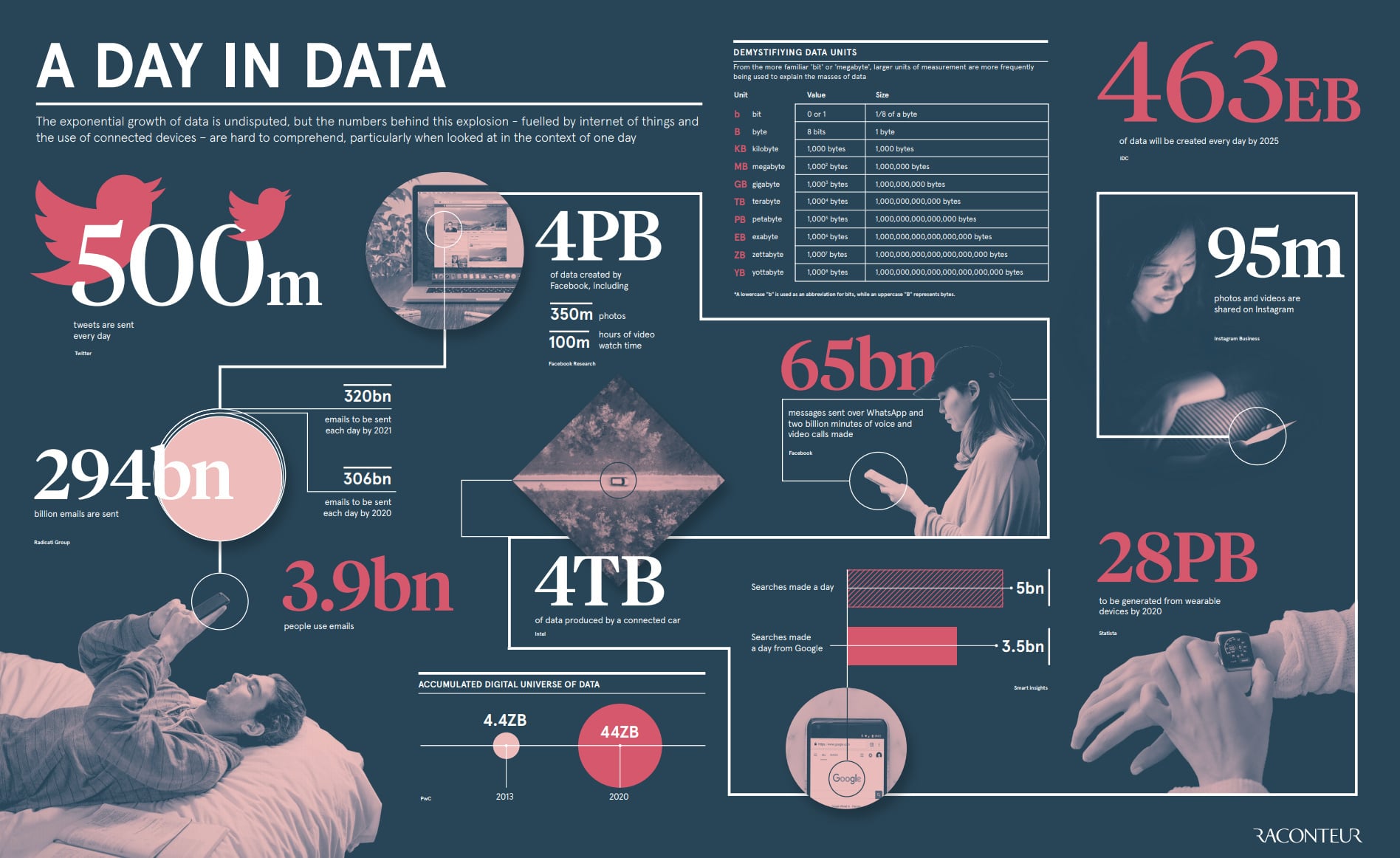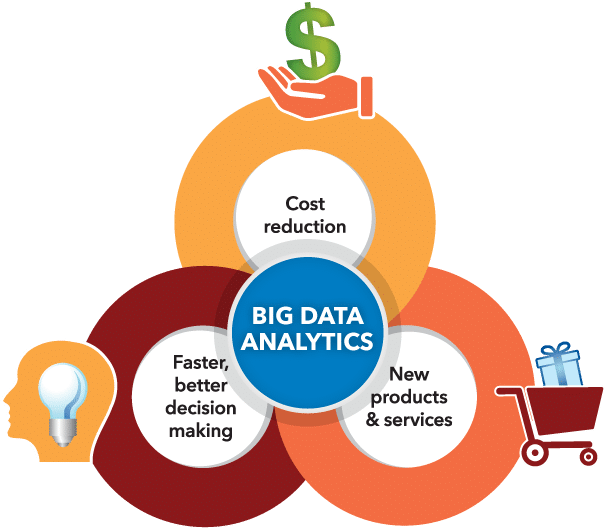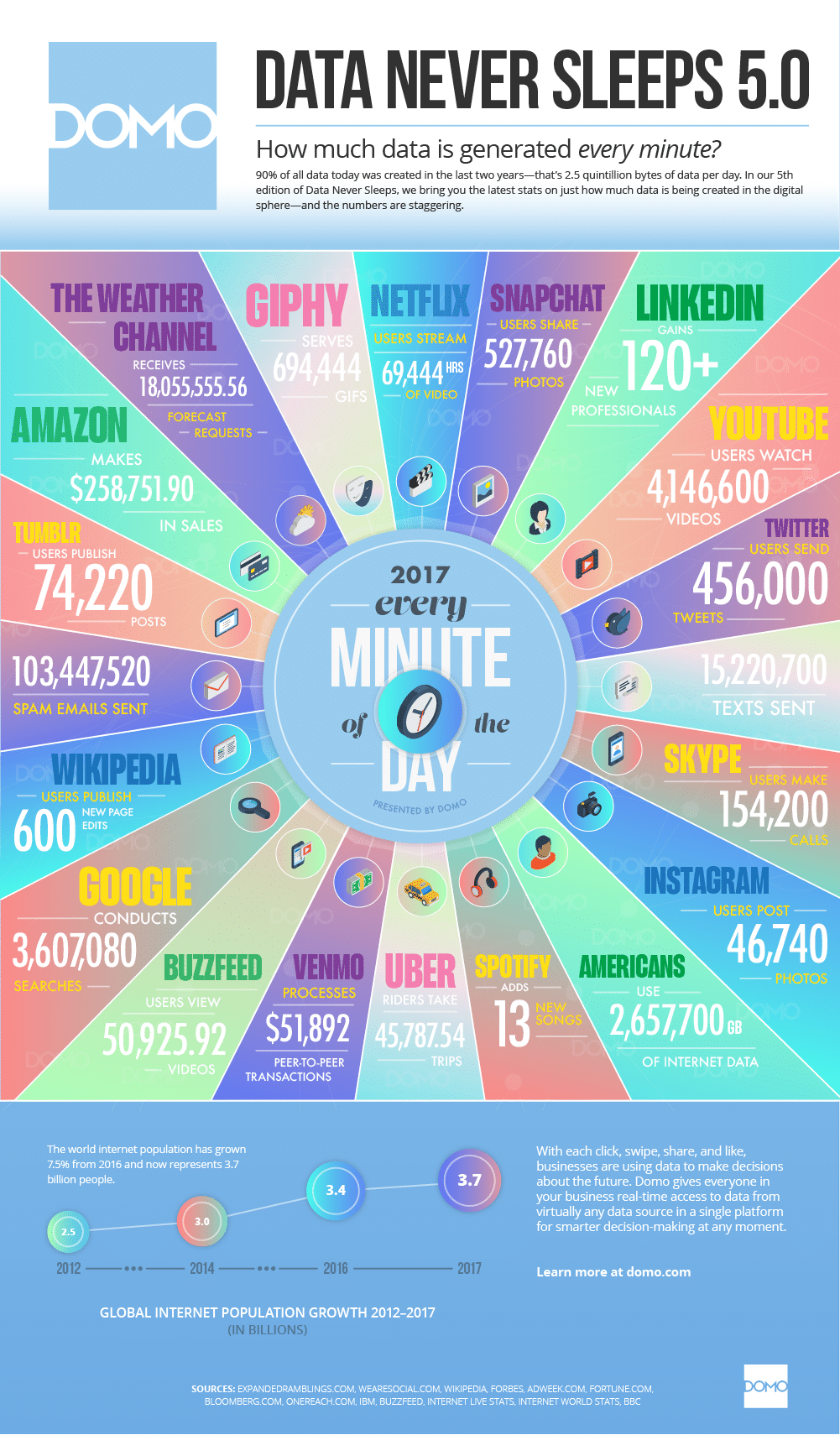Big data is already everywhere.
You’re contributing to it every time you watch a show on Netflix, post something on Twitter, or have a quick phone call with a business.
According to studies, by 2025, we’ll be creating 463 exabytes of data every day. To put that into perspective, it’s about 212 million DVDs.

It’s no wonder that something this vast is affecting everything that we do. Big data in the modern landscape is at the heart of business planning, decision making, and strategies for customer experience.
In this blog post, we’re going to explore how big data will affect the future of business, and what today’s companies can do to take advantage of the data downpour.
How data scales in terms of units
| Abbreviation | Unit | Value | Size (in bytes) |
|---|---|---|---|
| b | bit | 0 or 1 | 1/8 of a byte |
| B | bytes | 8 bits | 1 byte |
| KB | kilobytes | 1,000 bytes | 1,000 bytes |
| MB | megabyte | 1,000² bytes | 1,000,000 bytes |
| GB | gigabyte | 1,000³ bytes | 1,000,000,000 bytes |
| TB | terabyte | 1,000⁴ bytes | 1,000,000,000,000 bytes |
| PB | petabyte | 1,000⁵ bytes | 1,000,000,000,000,000 bytes |
| EB | exabyte | 1,000⁶ bytes | 1,000,000,000,000,000,000 bytes |
| ZB | zettabyte | 1,000⁷ bytes | 1,000,000,000,000,000,000,000 bytes |
| YB | yottabyte | 1,000⁸ bytes | 1,000,000,000,000,000,000,000,000 bytes |
Why is big data important?
Big data is an umbrella term referring to large volumes of structured and unstructured data that we collect and produce on a daily basis. Every customer/brand interaction is a source of data, as is the content that companies publish on their website, and the actions that search engines record each day.
This constant stream of information isn’t just noise; it’s a valuable insight into the reality of the world we’re living in. Interpreting big data allows companies to create new growth opportunities by better understanding their target audience. Your data can also offer an insight into which of your team members are the most productive, or how you can make your office more efficient.
Netflix is an excellent example of the value of big data. In October 2019, Netflix had over 163.5 million subscribers. The company revealed that by using big data it saves up to $1 billion a year on customer retention. That’s because Netflix better understands how to tempt you with the shows you’ll actually want to watch.
A whitepaper produced by SAS also revealed that big data delivers limitless growth opportunities to companies, by contributing to better and faster decision making. With data, you can figure out how to make your teams more productive, and plan for better products based on your customer’s preferences.

Big data contributes to the business intelligence that allows companies to improve their return on investment. With every insight you glean from your data, you’re one step closer to reducing the amount you waste on marketing campaigns that don’t work or strategies that don’t deliver. Big data:
- Gives you a complete end-to-end view of your customer’s journey;
- Helps you understand your customer’s sentiment towards you;
- Shows you how to improve employee performance;
- Boosts your chances of enhancing your product’s potential; and
- Highlights gaps in your market strategy
Big data applications in business
To better understand the applications of big data in business, let’s take a closer look at how companies can use this technology to their advantage.
1. Improving the customer experience
One of the most popular ways to leverage big data in the current landscape is to access information as way of improving customer experience. Experts agree that customer experience is the key to success in today’s landscape. However, figuring out what your customers actually need from you isn’t always easy. The good news is that the answers to your biggest questions about customers are already there, hiding in your existing data sets.
With big data analytics, you can unlock the sentiment, preference, and requirements hidden in your conversations with customers. For instance, Target in the US once used data analytics to predict customer pregnancies and offer them more relevant promotions as a result!
2. Transforming the hiring process
People are the most important asset in any business. It’s not just your customers that matter, but the employees that serve those clients on a daily basis. Today’s companies are often struggling to find the right talent to add to their teams. HR experts usually need to sift through mountains of applications before they can find anyone suited to a job.
Unfortunately, slipping up and making the wrong choice with a candidate is a costly issue. Experts say that the cost of a bad hire is up to 30% of that person’s annual earnings. With big data, however, you can feed analytics engines and AI algorithms that tell you exactly who to hire based on the skills you need.
3. Improving decision making
Big data can improve your ability to make the right decisions in almost every area of your business. Because data is the key to fueling things like analytical apps and artificial intelligence, it’s also crucial to delivering the kind of insights leaders need to move their company forwards.
When plugged into the right applications and cloud computing services, big data analytics can give you answers to some of your most pressing questions. For instance, you could use data from a workforce optimisation tool to determine what your employees need to do their best work. You can also use big data analytics to decide where to invest money into extra products for potential peaks in demand. Your data tools could even tell you when you’re likely to need more staff in your contact centre based on previous trends.
How to take advantage of the power of big data
Big data technologies are becoming more robust and powerful all the time.
As the amount of information that we collect increases, applications and tools are appearing to ensure that businesses of all sizes can access the value of big data for themselves.
The question is, how do you take advantage of this information?
Start with a goal
The first step in accessing the potential of big data is deciding exactly what you want to do. There’s tons of information out there, but not all of it will be relevant to your goals. Deciding what you want to accomplish with your data will help you to choose where to start looking.
For instance, if your goal is to improve the quality of your products, then you might start by collecting data from customer feedback, and satisfaction scores. If your aim is to improve the performance of your team members, then you would focus on things like contact centre analytics, and the number of calls handled. You could also look into workforce optimisation tools.
Find the right tools
Big data is everywhere, but we can’t use it in its raw form. Sorting through so much information would take hundreds of years, and endless manpower. That means that we need systems and tools that allow us to sort through the data that’s available as quickly as possible.
For instance:
- CRM and contact centre tools
CRM or customer relationship management tools can help with gathering data about the customer journey. Combined with insights from your contact centre, and the way that people in your team handle calls, you can unlock strategies for improving the customer journey. The key to success here is making sure you have the platform you need in place for connecting all of the information from every customer touchpoint in one place. Remember that the customer journey has more channels than ever today, from social media, to video conferencing and beyond.
- Workforce analytics
If your goal with big data analytics is to improve the performance of your team, workforce optimisation tools can help. These software solutions gather information about your employees, such as number of calls handled, or customer satisfaction rating. Analysing this information will show you the gaps in your strategy, and which team members need additional training.
- Business intelligence
Business intelligence (BI) tools provide an overview of critical performance analytics, designed to help you make better decisions. With BI technology, you can access things like real-time information on how your team is performing, historical data, and more. You might even set up a real-time dashboard where team members can see how well they’re doing based on specific metrics.
Implement strategies to drive innovation
More often than not, the purpose of big data in the business landscape will be to drive a strategic transformation. Whether you’re paying attention to customer experience, or you’re trying to boost the performance of your team members, your data will help you to innovate and evolve.
The important thing here is to make sure that you have a system in place for implementing new strategies. Once you know what’s holding your business back, or where new opportunities exist, how will you decide where to go next? What kind of decision makers do you need to take your ideas to? Have a plan of action that you and your team members can follow to leverage the data you collect.
Big data and cloud computing: A perfect combination
As mentioned above, there are many tools that businesses can use to enhance their use of big data, and make sure they’re getting the most out of the information they collect. However, few things are more essential to the success of a big data strategy, than cloud computing.

We’re already creating around 2.5 quintillion bytes of data every day, and the speed of creation is constantly increasing. With so much information to sort through, it would be impossible to hold all of this data on a traditional storage system.
To unlock the power of a constantly-scaling level of data, you need something flexible. That’s where the cloud comes in. Cloud technology is infinitely elastic. Companies can access the cloud to host endless amounts of information from contact centres, communication stacks, and more. This means that your business won’t be constantly running out of space for new insights.
Big data and cloud computing make for the perfect combination. While big data allows us to access an infinite amount of constantly expanding information, cloud computing gives us a space to store all of that value. What’s more, thanks to as-a-service cloud solutions from vendors, companies can add to the functionality of their cloud environment at any time.
Tools to help address big data processing issues in the cloud
Although the cloud and big data make for perfect partners, they can only deliver the right results when supported with the correct tools. As-a-service solutions are often the key to making sure that you can process data correctly in the cloud.
In today’s cloud landscape, you can access things like contact centres on the cloud, which allow your employees to work from anywhere, and also collect data as they go. These contact centres in the cloud can also come equipped with analytics already built-in. This helps to overcome issues with big data processing in the cloud.
Your as-a-service provider can also ensure you have everything you need to keep your data strategy secure and compliant too. This includes providing encryption strategies that prevent criminals and external parties from accessing the information that you collect. What’s more, it could also mean ensuring only non-personal data is stored when permission hasn’t been obtained from a customer. This keeps you in line with GDPR guidelines.
Here are some benefits of as-a-service technology provides:
- Elasticity and scalability: You can add more bandwidth to your cloud environment as your business grows and your data scales.
- Simplified infrastructure: With an as-a-service provider, you get your cloud environment handled for you. There’s no need to worry about complex data centres in your business.
- Improved analytics: Cloud providers offer access to endless ways to upgrade and transform your data landscape with new tools like AI, machine learning, and improved analysis.
Big data analytics is the future of business
Ultimately, in a world where experience is key, and businesses are constantly fighting to differentiate themselves, there’s nothing more valuable than data. Big data provides companies with the scale and insights they need to develop a realistic path for growth. With the right analytics and tools in the cloud, you can accomplish anything with big data.
The right big data technologies will show you how to connect with your customers on a deeper level, and what you can do to make your team more efficient. Data gathering systems also give you the power to streamline business operations and reduce your outgoing costs, while building your bottom line. In the years to come, any business that isn’t taking advantage of big data will be missing out on endless opportunities.
Originally published May 21, 2020, updated Jan 16, 2023
